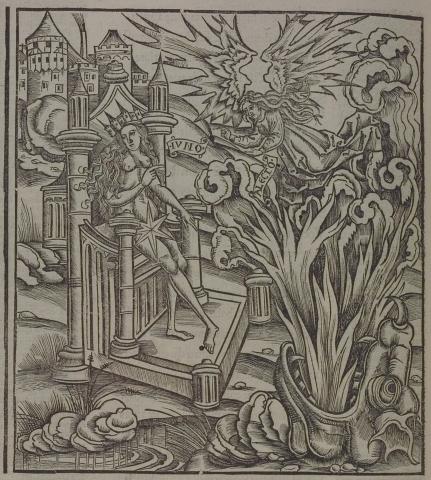Annotations
Allecto, with her fiery wings and snakes for hair, has flown up to the heavens to tell Juno of her success (540-51). Juno, sitting in her throne, turns her face away from Allecto; one hand points at Allecto, and the other points toward the mouth of the underworld, which is positioned directly below Allecto. Her movements may indicate her telling Allecto to stop with her exploits in Italy and to return immediately to the underworld (552-60). The mouth of the underworld, shaped like the head of a dragon, exhales sulfurous fire and smoke, which seems to almost swallow the lower half of Allecto's garment. In the image, the mouth of the underworld is positioned to the right of a small pool, that appears to be rippled by a small amount of disturbance. According to Vergil, this entrance to Dis is located in a cavern in the midst of a torrenting river, in the middle of a dark dense forest (563-70). (Katy Purington)
Woodcut illustration from the “Strasbourg Vergil,” edited by Sebastian Brant: Publii Virgilii Maronis Opera cum quinque vulgatis commentariis expolitissimisque figuris atque imaginibus nuper per Sebastianum Brant superadditis (Strasbourg: Johannis Grieninger, 1502), fol. 302v, executed by an anonymous engraver under the direction of Brant.


Sebastian Brant (1458-1521) was a humanist scholar of many competencies. Trained in classics and law at the University of Basel, Brant later lectured in jurisprudence there and practiced law in his native city of Strasbourg. While his satirical poem Das Narrenschiff won him considerable standing as a writer, his role in the transmission of Virgil to the Renaissance was at least as important. In 1502 he and Strasbourg printer Johannes Grüninger produced a major edition of Virgil’s works, along with Donatus’ Life and the commentaries of Servius, Landino, and Calderini, with more than two hundred woodcut illustrations. (Annabel Patterson)